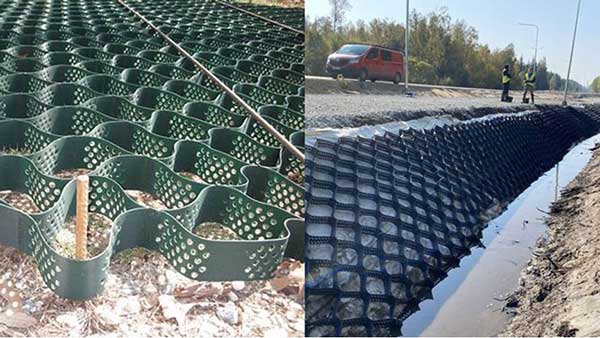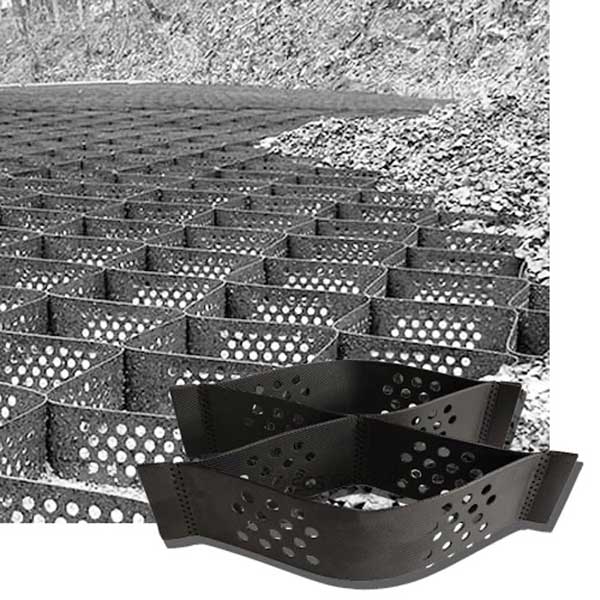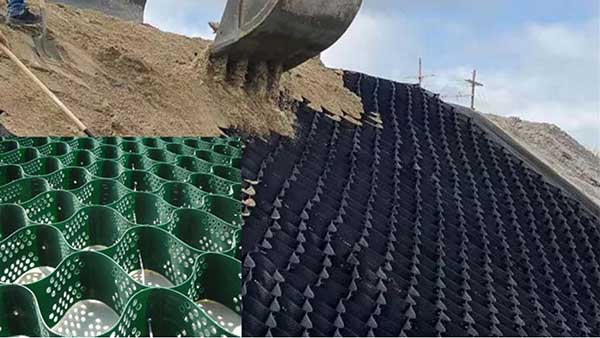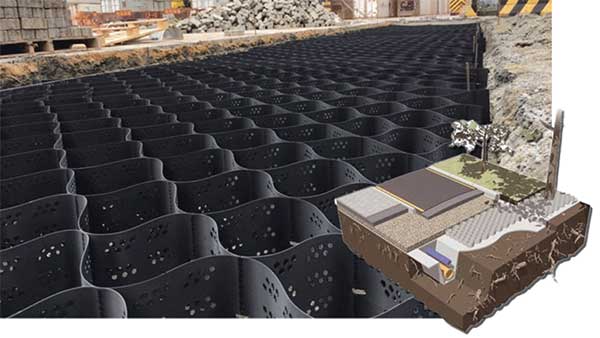|
Designed for both small residential and large commercial projects we offer a full line of professional erosion control products which are designed for a variety of different settings and applications. For help with sizing or any product related questions please
contact us.
Geocell Slope & Ground Stabilization Products
Geocell Erosion Control Products
CS Series Cellular Confinement System
This system uses the strength and absorbent abilities of TYPAR Geotextiles to form a 3-Dimensional cellular confinement system. The GS Cellular Confinement System is made from dark gray PP/PE bicomponent fiber geotextile. The cell walls are absorbent to water, air, and nutrients which increase stability and fertile performance. This system is shipped in compacted panels that expand into a honeycomb structure to the desired shape and dimension needed on the site.
Its unique, lightweight, and flexible material adjusts to various surfaces for easier installation and will also resist any impact damage. You may use different infill materials such as soils and recycled materials such as sand, gravel, and pebbles; to provide the reduction in waste and save on construction costs.
The GS series cells sends downward extractions, laterally, reducing the loads onto underlying soils. The cellular confinement system is perfect for offering excellent stabilization over poor soil conditions. This will reduce constructed profile depth and costs while protecting soil and roots from consolidated sediments. This will give site access for:
• Heavy, light or industrial vehicles
• Base Reduction
• Improved Entrance Over Poor Soil
• Offers Increased Longevity
• Protection of Tree Roots
• Highways
When Used in Slope Protection:
This cellular structure is perfect for improving the resistance of erosion on steep, unstable areas or slopes that are exposed to severe hydraulic or mechanical pressures. With different cell depths and diameters, this will offer cost efficient options for protection up to 1:1 (45 degrees) slopes
• Landfills
• Mining
• Highway
• Bridge Abutments
• Embankments
• Appropriate Applications
Geocells Installed on the Bank of a Waterway
Cellular Confinement System for Earth and Water Flood and Water Control:
The battle to prevent flooding runs into the millions of dollars in construction or temporary dam raising. If flood waters are not properly contained, it can lead to loss of life, millions of dollars from property damage, and the incalculable toll on everyone's livelihoods.
Although the most common practice for controlling floods are the use of sandbags. The cell structure has many advantages over sandbags. Filling sandbags take a great deal of time and energy. Workers become easily tired and terrible choices must be made to decide which areas will be protected and which won't.
Less labor is required than filling and stacking sandbags because earth-moving machines can fill the cells with sand very quickly. Also, the cells are constructed as a vertical wall, where sandbags must be stacked similar to the shape of a pyramid, and great deal more sand will be needed.
Easy to construct, these cells are lightweight, are very rugged and exceptionally strong to withstand different levels of water volumes. The units can be carried by hand and brought in on equipment or dropped from helicopters without causing any damage. You can store the units out of the sun for years without deteriorating and will resist mildew and pests. These units are very effective as flood control barriers and for levee construction; both rising and repairing.
Gun Firing Range Protection Walls Applications:
These walls are an all-textile cellular containment system used for constructing structures from earth, sand, and other materials. When filled with sand or earth, the cell wall has no metal or plastic components, making it perfect for use at gun clubs. Fire range walls have ricochet hazards that need to be addressed for the reduction or elimination of these dangers.
TYPAR GeoCell is the ultimate solution for the construction of small arms and close-quartered battle ranges. It will allow for a realistic, close quartered battle training with high-velocity weapons. It provides internal wall protection for multiple teams within the complex. It's also a very effective solution to add needed height on existing range wall berms, the addition of range dividing walls, obstacles and target protection.
These units are extremely flexible, cost effective modular alternative to standard range building techniques, providing maximum flexibility with minimal maintenance
Applications Include:
• Firing Range Walls
• Gun Clubs
• Ballistics Protection
• Blast Protection
• Vehicle Barriers
• Force Protection
Geocells Being Filled on a Hillside
Construction Erosion & Sediment Control:
Water can erode top soils, wash away priceless plantings, pollute downstream and create enormous gullies. Even though these are regulated issues, current erosion control products can become overwhelmed by the soil and water that they are supposed to prevent.
The heavy-duty geotextile fabric of these units adapt to the terrain while providing excellent structural durability and strength. As a matter of fact, the easy to construct cellular confinement system is perfectly suited for irregular terrain including slopes, in order to reduce erosion while promoting vegetation. These systems are also cost efficient as you can use mulch or fill from the site. Water filters through the system while fill materials and soil particles are kept back by the geotextile.
Once the erosion and sediment issues are gone, the cells can be emptied and used again, saving a great deal of money. These cells are extremely effective against mud slides and a perfect solution as debris flow barrier.
Other Uses:
• Sediment Pond Berms
• Check Dams
• Filter Screens For Pond Spillways
• Mulch Berms
• Sediment Trap Filter Berms
• Silt Screening
• De-watering Filters
• Erosion control on slopes and channels.
Mining Containment:
There is a growing demand for domestic fuel production which has increased fracking and clean coal production. This has resulted in more stringent regulations on slurry and waste water byproducts to protect against spills and contamination.
TYPAR GeoCells also offer a secondary confinement solution to create a much higher containment site while providing the ability of recycling fill material. This has proven to be very effectual. Reducing a site's footprint is critical to mining areas where elevation changes and topographic relief to minimize environmental impacts and costs. Using cellular confinement technology can drastically reduce the cut and fill needed to level a site while improving the return on investment.
This has been proven by the Army Corp of Engineers Environmental Research and Development Center and through Military applications. They can be trusted to contain 100% waste materials during any catastrophic failure of a primary tank.
Geocells 101: Uses and Typical Installation Information

Above:
Geocells Installed on a Hillside in an Erosion Control
Application
Geocells are a newer technology of the last couple of decades used in the
construction and civil engineering industries. Geocells represent a 3D grid (not to be confused with
geogrid which is flat in shape) and are installed into into the ground in many different settings and for many different reasons. So what are
geocells, and why are they so popular?
Geocells are vinyl web structures placed on the ground to provide
structural support and stability when filled with soil or aggregate
material. Geocells are commonly used for driveways, roads, and other soil
stabilization. They are also used for erosion control on hillsides and are
popular because they last 20+ years on average and are easy to install.
This article explains what geocells are, how they work, and what they are
used for. Then, we explain how they are used for soil stabilization and how
much weight geocells can hold. Finally, we go over how to install geocells,
what geocells are made from, and all the great benefits of geocells.
What Is a Geocell?
Geocells reinforce roads that have high traffic or need their structural
strength improved. Geocells go in the ground under the surface, which is
usually concrete, pavement, or gravel. With the geocells in the ground, the
surface does not sink as much when people walk or drive on it.
A geocell, also known as a cellular confinement system, is an
in-ground support system, usually by civil engineers. Sometimes the ground
is not stable enough to be used as a road or for other uses, and the ground
needs some help to do so, which is why there are geocells.

Above: Geocells Installed in a Gravel Area
Geocells also make roads and other surfaces last longer since
they have additional support and are not sinking in as much as
they would without the geocells.
Without the geocells, the
soil, rock, or whatever else is underground can shift
significantly over time, making it weaker. The weakening is
expedited when there is high or heavy traffic on the roads. But
the reinforcement from the geocells makes the weakening a much
slower process. Geocells are often employed in situations where
roadbase geogrid material will not provide an adequate level of support as what is required for the overall stability of the roadway or parking area.
The next section explains how geocells work
to strengthen the ground.
How Do Geocells Work?
Geocells work using a honeycomb shape that needs to be filled in. When a road or other soil or materials in the ground need to be stabilized, engineers or construction workers add a geocell to add the support it needs.The geosynthetic plastics that geocells are made from, which we will detail later in the article, are expandable and flexible. When geocells expand, they can hold a lot of weight on them with the help of the ground around them and the filler in each cell.The flexibility of the geocells makes it so that the weight from people, vehicles, or anything else that goes on the ground they are in does not damage them. They can bend slightly so that they will not break when there is a lot of weight on them.The walls of each cell are connected with strips. They can handle materials in various sizes and strengths, but they are still strong enough to keep the materials in place.
Then, all
the cells are filled with soil, sand, rock, gravel, or concrete;
even if the filler material would not be strong enough to act as
a road or stay on its own, thanks to the geocells, it can.
Within each cell, the materials can shift around but cannot
move significantly. However, liquid can still drain from the
geocells, so they do not get overfilled. The compactness of the
materials within the cells is what gives geocells their
strength.
What Are Geocells Used For?
Geocells are used for several reasons, including erosion
control, channel protection, structural reinforcement, and soil
stabilization. The geocells for all of these uses are the same
few types of geocells we discuss throughout the article, but the
material and installation vary.
Erosion Control
The first use of geocells is for erosion control. Erosion is
common on steep slopes where the ground or soil is not secure.
Erosion can damage the environment around the slopes and even
create a risk of danger if there are people or animals in the
area of the slope where erosion occurs.
Geocells can help
prevent erosion. When geocells are installed in these sloped
grounds and other areas where erosion is common, we can control
the erosion so it is not as severe or even prevent it
altogether.

Geocells keep the filler in place, whether soil, stones, or
something else. When it cannot move as easily thanks to the
geocells, the risk of erosion in the area decreases
significantly.
Channel Protection
The next use of geocells is channel protection also known as
Swales. Channels and other hydraulic structures need something
to line them to keep them functioning and in place. Geocells are
used to protect the lining of channels, so they stay in place
and do not damage the structures. Structural Reinforcement
Another way that geocells are used is for structural
reinforcement. Geocells reinforce structures like railroads, so
they face a lower chance of getting damaged and require fewer
repairs, even when they are used frequently.
Structural
reinforcement from geocells is common with railroads since they
have high traffic from the trains, which are very heavy. The
geocells keep the railroads from getting damaged, which would
make it so you cannot use them until they are repaired. Without
the geocells, there is less support for the railroads and the
trains, but with the geocells, they have more support which
keeps them functioning.
Soil Stabilization
Finally, soil stabilization is the most common thing that
geocells are used for. Soil stabilization is when the geocells
are used to strengthen the ground on roads and walkways. We
explain this use of geocells in-depth in the next section.
The difference between structural reinforcement and soil
stabilization is that structural reinforcement is for buildings
or transportation methods that are always in place. On the other
hand, soil stabilization is more for natural uses that are not
as big or heavy, like roadways, walkways, or even just a field
or park.
The structures that need geocell reinforcement are bigger,
whereas the other types just need more ground support. The
bigger structures will need constant maintenance or even stop
functioning without the reinforcement from geocells. The soil
will just get overused and need to be replaced, but it will not
cause any structural problems or outages.
How Are Geocells Used for Soil Stabilization?
Geocells are used for soil stabilization by making the soil
stronger. One of the physical ways to stabilize soil is with
geocells. Geocells can be placed in the ground amongst the soil
to provide additional support.

Above: Geocells Installed in a Load Support Applicaion
Without geocells in the soil, the soil can get beat down and
spread out over time. This soil compaction and spreading process
speeds up the more the ground is used from heavy traffic or
environmental factors like weather.
However, when
geocells are in the ground, the soil cannot move and has to stay
within its geocell. The walls of each cell keep the soil in
place so it cannot move around or become too compact. Keeping
the soil in place keeps the ground strong and prevents extreme
weather or heavy traffic from changing the soil.
Note: When discussing the term "geocell" retaing wall support is often mentioned. If you are looking to provide additional support to a retaining wall a geogrid fabric is the more appropriate product. Geogrid is typically placed between layers of blocks in a retaining wall to provide support.
Soil
stabilization is the way in which we discuss geocells throughout
the remainder of the article, including installation.
How Much Weight Can Geocells Hold?
Geocells can hold a lot of weight, which is good since they need
to last a long time, and people will be walking or driving over
them, sometimes in heavy vehicles. Different geocells can hold
different weights depending on what they are made for.
Geocells are made to hold a variety of weights. The lowest
weight that a geocell will hold is around 8,000 pounds (3,600
kg). The strongest geocells can hold thousands of pounds,
usually around 80,000 (36,000 kg).
The smallest geocells are not meant for cars or anything too
heavy-duty. Usually, they are for pedestrian walkways and small
paths, like paths on golf courses for the golf carts. The cells
are three inches (7.6 cm) deep, and one 215-square-foot-geocell
sheet (20 sq. m.) can hold up to 8,000 pounds (3,600 kg).
Mid-size geocells are an inch (2.5 cm) deeper than the small
ones. One set of geocells at 215 square feet (20 sq. m.) holds
40,000 pounds (18,000 kg). These geocells are best for
driveways, normal roads, and parking lots. These geocells are often referred to as "
driveway grids" and are best for driveways, normal roads, and parking lots.
Finally, the
biggest geocells are made for the biggest and heaviest vehicles
like boats, construction and commercial vehicles, and large
driveways. These geocells are six inches (15 cm) deep for
maximum support. A 215 square foot (20 sq. m.) of geocells can
hold 80,000 pounds (3,600 kg), which is ten times more than the
three-inch (7.6 cm) geocells.
Geocells can last for up to
seventy-five years if installed correctly.
How To Install Geocells
Now that you know what geocells are and how they work, you need
to know how to install them. This section explains how to
install geocells for soil stabilization. Slope stabilization
requires a different process not detailed in the following.
Here are the steps you need to take to install geocells for soil
stabilization.
1. Prepare the soil
2. Expand the
geocells
3. Lay and fill the geocells
The more geocells you have to install, the more people you will
need to help you install them. Not only will this make the
installation process go faster, but you will also be able to
make sure the geocells expand and are laid properly.
1. Prepare the Soil
First, you need to prepare the ground for the geocells. The
ground needs to be flattened, and the depth of the hole you dig
to install the geocells and the compactness of the ground will
depend on the size and width of the geocells you are installing.
The greater the depth of the geocells, the deeper your hole
needs to be.
Next, once the ground is ready, you need to cover it with a
geotextile. The
geotextile is a barrier between geocells and the
ground. It will help keep the soil and the geocells in place.
This way, the geocells are protected if anything happens to the
ground. The geotextile needs to cover all the ground on which
the geocells are being installed.
Then, you need to place a biaxial grid on top of the geotextile.
The biaxial grid you install depends on the geocells you
install.
2. Expand the Geocells
The next step is to get the geocells ready to install. They do
not come in fully expanded since the size is so big. They need
to be expanded when you are ready to install them.
Depending on the area you are covering and how many sheets of
geocells you are going to install, you will need help expanding
the geocells. The larger the sheet of geocells that you need to
install, the more people you need to assist with the
installation.
To keep the geocells expanded, you will
need to staple or compress them so they stay in place. The more
cells you have to install and the deeper the geocells you are
installing, the more staples you need to hold them in place.
When you expand the geocells, you want to make sure they are
fully expanded before you staple them. If you do not fully
expand them, you will not have enough geocells to cover the
entire area since the measurements will be off.
To help
expand them, you will want to have more than one person working
on the installation. Pull them to the edges until they are fully
expanded, then have one or more people in the middle staple them
while expanded.
3. Lay and Fill the Geocells
Now that the geocells are expanded, and the ground is ready, it
is time to lay them on the ground. All you need to do is place
them on top of the ground you prepared. If you measured the area
correctly and got the right amount of geocells, your geocells
should completely cover the ground.
Make sure all the geocells are sitting on top of the geotextile.
If for any reason, you do not have enough geocells to cover your
area, you need to get more and cover your entire area before you
can continue onto the final step of filling the geocells.
Finally, you need to fill the geocells. The geocells need to be
filled, and the filler needs to cover the geocells by two to
three inches. You need to make the filler compact, so it stays
in place and keeps the filler completely flat on the top.
|